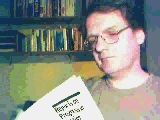|
Research Associate Professor Office (206) 543-7585 Lab (206)
543-0210 |
 | |||||||||||||||||||||||||||
|
Policy: Visitors of this and related pages are held anonymous, no records are taken or stored in any form.
Research InterestsThe research is aiming at the correlation between atomic structure and observed optical properties. New chiral substances are synthesized as models for structure-feature studies, for example from adding chiral ligands to isothyocyanates. These new substances crystallize well and allow a multitude of variations of their chemistry while being strongly structurally related. Similarly, structural phase-transitions cause variations in structures which are the cause of sometimes strong changes of the optical properties. New optical measurement techniques are developed to collect data on chiroptical properties like optical rotation, Faraday Effect, circular dichroism, the electro-optic effect, and electrogyration. Such new methods are:
of light which allow calculating electrogyration, the electro-optic effect and the d-coefficients for frequency doubling, using the atomic structure and empirical polarizability volumes for the individual atoms. Crystal growth from aqueous or other solutions and their crystallographic characterization (forms, structure, and basic physical properties) assist the research. The aim is to provide large samples of interesting chemical composition in the size-range of cube-centimeters. X-ray structure determination and chemical analysis as part of the duties for the Department of Chemistry in Seattle complement these studies. I devoted some of my time to the development of software packages to aid the teaching of physical crystallography. This resulted in one program for the presentation of tensorial features in form of representation surfaces (WinTensor for Win95/98/NT/2000/XP) and another program for the presentation of crystal morphology as virtual reality models (WinXMorph for Win95/98/NT/2000/XP). Special Achievements (in chronological order)1. Periodic table of Verdet constants of Ions. The Faraday rotation of over 250 cubic crystals was studied and the first and so far only comprehensive compilation (almost complete periodic table) of specific Verdet constants of elements in different valence states was derived, including temperature dependence. 2. The first to measure complete Verdet tensors in non-cubic crystals, including triclinic symmetry. 3. Algorithm to invert numerically a sinusoidally varying signal with smoothly changing amplitude. 4. The tilter method. A method was developed to measure the optical rotation of birefringent solids ca. 1000 times faster than competing methods. 5. The first (and so far only) to measure optical rotation topographs in birefringent solids. 6. The DES-model. A theory and software was developed to calculate the electro-optic tensor, the d-coefficients, and the electro-gyration tensors in crystals of any symmetry from the x-ray structure and empirical polarizability volumes of the atoms. 7. Solving the over 100-years old problem of Pasteur's findings of optical rotation in solutions versus crystals of Tartaric Acid. 8. Developing an imaging system to unfold images of birefringence, eigenrays and transmittance. 9. Solution to the problem of ambiguity of birefringence measurements. 10. Discovery of anomalous azimuthal rotation in dyed crystals (AAR) 11. First to measure circular dichroism images with a new device, U-pol, (patent pending). 12. Discovery of AAR related anomalous circular extinction in dyed crystals (ACE-effect). 13. Development of a system to unfold images of birefringence, eigen rays and transmittance on a millisecond timescale. 14. Two educational software packages, WinTensor to study tensorial properties and WinXMorph to study crystal morphologies are licensed through the University of Washington 15. The first to measure images of the electro-optic effect in birefringent solids. | ||||||||||||||||||||||||||||
Department of Chemistry
University of Washington
Box 351700
Seattle, Washington, 98195-1700
Voice: (206)543-1610
FAX: (206)685-8665
[Chemistry Home] [University of Washington] [Contact the Department] [page top]
L3xicon.com - a web thesaurus and lexicon listing Cad4.cpac.washington.edu under kaminsky, optical rotation and physical crystallography
KwBrowse.com - browse the Keyword Map of cad4.cpac.washington.edu